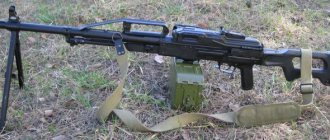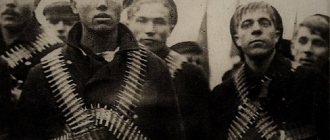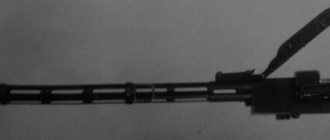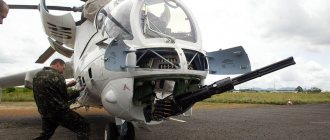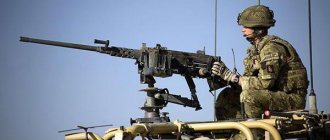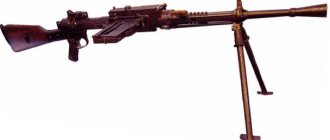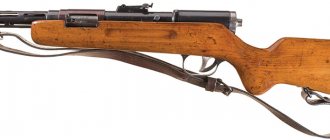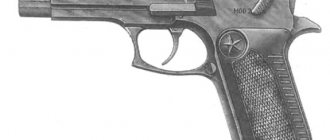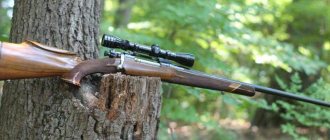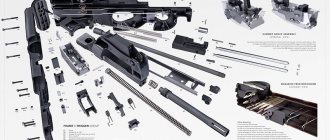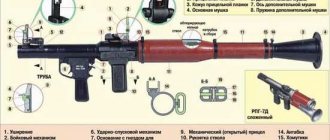26.05.2012
American Browning M1918 light machine gun (BAR)
J. M. Browning's automatic rifle BAR
(
Browning Automatic Rifle
) was created in 1917. While working on the automatic rifle, the designer assessed the experience of the First World War. First of all, this was manifested in the introduction of a fire mode translator and a replaceable magazine. In the United States Army, the BAR became a light machine gun with the maneuverability of a rifle, and its crew consisted of one man.
The rights to manufacture the Browning Automatic Rifle were acquired, but the possibility of its production by others remained (Winchester). Production began in February 1918, but BAR's combat experience in World War I did not go beyond military testing. Despite this, both the French and the British rushed to order BAR. Under the obvious influence of this machine gun, the French created the Chatellerault light machine gun.
The design of the BAR machine gun was based on the Vickers-Berthier system of the 1908 model, which had minor modifications. The barrel in the receiver was fastened with a thread (this fastening did not allow the barrel to be replaced in combat conditions) and was equipped with a smooth muzzle sleeve - “extension”. At first, five and later four left-hand rifling were made in the barrel bore. Their stroke length was 254 millimeters. The automation worked thanks to the removal of powder gases from the barrel bore. The gas chamber is a closed type. The gas regulator, having three holes, was screwed in front of the guide tube. A swivel clamp and a wooden forend with a notch were attached to the guide tube.
The barrel bore was locked by a lever hinged to an eye located in the middle part of the bolt. The bolt was attached to the bolt frame through a hinged earring. There was a protrusion at the top of the milled receiver. A return spring was placed in the guide tube.
While the moving system was moving forward, the shutter reached the stump of the barrel and stopped. The bolt frame, continuing to move, rotated the earring, and the rear part of the locking lever rose. The supporting surface of the lever was wound behind the supporting surface of the receiver protrusion. After the shot, the bolt frame moved back, lowered the lever and unlocked the barrel.
An insert placed under the earring axis prevented premature unlocking. He did not allow the locking lever and the earring to lower until the bolt carrier reached the appropriate position. The cartridge case was removed by the bolt ejector and the rigid reflector of the trigger box. The bolt frame hit the buffer at the rearmost point. When firing, the charging handle remained motionless.
The trigger mechanism (trigger mechanism) allowed for both single and continuous fire. After the barrel bore was locked, the insert struck the firing pin mounted in the bolt. Before locking, the locking lever did not allow the striker to advance, and when unlocked, it was retracted. That is, the combination of the locking lever and the protrusion of the striker acted as an automatic safety device. The trigger, equipped with a buffer spring, was mounted on a frame, which was located inside the trigger box. When the trigger was pressed, the disconnector connected to it raised the front end of the trigger lever, releasing the bolt frame from cocking.
The translator-safety flag was located behind the trigger guard on the left. In the forward position (“F”), the disconnector rose and jumped off the trigger lever. He, in turn, returned to its original position, intercepting the bolt frame. If the flag was in a vertical position (“A”), the translator’s pin limited the rotation of the trigger lever in such a way that there was no disconnection, and the automation cycle was repeated. If the flag was turned back (“S”) the trigger was blocked by a pin.
A folding frame sight was installed on the receiver. The butt, which had a semi-pistol protrusion, was put on the tail tube of the receiver and secured with a screw, reinforced with a metal back. The sling swivel was attached to it from below.
Food was supplied from a two-row box magazine. The arrangement of cartridges is staggered. The magazine latch was controlled using a button located inside the trigger guard. Thus, to speed up reloading, the shooter could press the latch using the finger of the shooting hand. The machine gunner carried spare magazines on his belt in canvas pouches. The BAR design consisted of 125 parts, 11 of which were springs.
“Winchester” and “Colt” provided the weapon with a good finish, and its mass made it possible to fire bursts with acceptable accuracy, but only from point-blank range. The combat rate of fire in short bursts was 60 rounds per minute, in long bursts - up to 180 rounds per minute, provided that the magazines were changed quickly.
In 1922, the United States Cavalry adopted its own modification of the BAR Model 1922 as a light machine gun that was carried without a pack. The barrel was weighted to 1575 grams and equipped with transverse ribbing up to the middle of its length. The frame sight, which has a mechanism for introducing lateral corrections, was borrowed from the Browning M1919 heavy machine gun. A bipod (weight 1.42 kg) was attached to the guide tube in front of the forend; the legs were fixed in the combat position with spacers. In the recess of the butt there was an additional folding support. The sling swivels were “thrown” to the left side, similar to a cavalry carbine. The BAR Model 1922 was produced in small quantities.
US Marines prepare to land on Tarawa Atoll. Behind are the M1 Garand and M1918 Browning rifles.
US police used a self-loading version of the BAR "Monitor".
In 1937, the army received the M1918A1 light machine gun, which was slightly different from the M1918. We installed a sight similar to the Enfield M1917 rifle. A folding bipod was attached in front of the forend, and a folding shoulder support was attached to the back of the butt. The M1918A1 did not reach the level of the Model 1922, but it was the Model 1922 that was completely withdrawn from service in 1940.
In 1941, just before the United States entered World War II, the significantly modernized BAR M1918A2 was adopted. Instead of continuous and single fire modes, continuous fire modes were introduced at different rates - 300-450 rounds per minute (flag “F” positions) and 500-550 rounds per minute (flag “A” positions). To simplify the operation of the gas regulator head, it has been modified. The sight is a Browning M1919 type. A metal plate was mounted into the shortened forend, which protected the recoil spring and the forend from overheating.
The barrel was equipped with a slotted flame arrester. The magazine guides were screwed to the trigger box, which reduced the risk of losing it. The shoulder support has been shortened. There was an additional support in the butt, but users almost immediately began to remove it (something similar happened with the DP butt support). The bipod was moved to the muzzle of the barrel and equipped with wide shoes. Thumbscrews were used for fixation. This position of the bipod limited the aiming sector and many machine gunners removed them, so over time the bipod was placed on the guide tube of the M1918A2 machine gun. In battle, machine gunners did not use the shoulder support either, so it was dismantled to make the weapon lighter.
A German soldier (possibly an officer) surrenders to an American soldier armed with a BAR M1918A2 automatic rifle
By the beginning of the war, the BAR was a squad and platoon weapon. The Americans continued organizational experiments during World War II, but each time the BAR again became the core of small fire groups. However, with a relatively light, non-replaceable barrel and limited magazine capacity, the machine gun could not provide long-term fire support. Even when firing in short bursts, the overheated barrel produced visible flames and smoke. It can be assumed that the lack of a light machine gun that satisfied all the requirements forced the Americans to introduce into the infantry squads soldiers armed with combat shotguns, which made it possible to conduct close combat in the thickets.
In addition to Marlin-Rockwell, Winchester Repairing Arms and Colts Patent Firearms, BAR was produced by New England Small Arms and IBM. The markings applied to the receiver included the inscription BROWNING BAR М1918 CAL 30 MFD BY (manufacturer's name).
Early production BARs were returned to factories during the war to be brought up to the level of the M1918A2. Since 1942, machine guns were equipped with a plastic butt, which was reinforced with a metal bottom plate and back of the head. In addition, there was a carrying handle. BARs were supplied to the UK for local defense forces between 1940 and 1941. American Marines preferred the M1918A2, which was modified in military workshops to give them a single-fire mode. In general, due to the large number of alterations and “local upgrades”, many variations of the BAR appeared.
The number of different models produced by BAR is estimated at 1 million pieces, of which more than 350 thousand Model 1922, M1918A1 and M1918A2 machine guns were produced in the United States in 1922-1945 and during the Korean War. After the single 7.62 mm NATO cartridge (7.62×51) was adopted, the T34 machine gun was specially made for it, but this BAR version remained only experimental. Although the BAR М1918А2 was officially withdrawn from service in 1957, it continued to serve later. The machine gun finally left the world stage only in the 80s.
To unload the BAR you must: disconnect the magazine by pressing the magazine release button located in front of the trigger guard. Pull the charging handle back. Inspect the chamber through the receiver window. Return the charging handle to the forward position and pull the trigger.
American soldier with various US Army weapons.
In the picture (counterclockwise):
1. Self-propelled howitzer NMS M7. Considering the prefabricated bow piece (not one piece) and the lack of folding sides of the wheelhouse, this cannot be a later model M7B1. The familiar name "Priest" is not suitable, since it was used in the UK, not in the USA. On the turret is a 12.7 mm (50 caliber) Browning M2HB machine gun.
2. 37 mm M3 anti-tank gun.
3. Easel 7.62 mm (30 caliber) Browning M1919A4 machine gun.
4. Thompson M1928A1 submachine gun.
5. Browning M1918A2 Automatic Rifle (BAR).
6. "Browning" M1917A1. Like the M1919, a 7.62 mm heavy machine gun.
7. 60 mm M2 mortar.
8. 81 mm M1 mortar.
In the inner circle are an M1 self-loading carbine, a Springfield M1903 rifle and a Colt M1911 A1 pistol; in the soldier’s hands is a Garand M1 self-loading rifle.
Procedure for partial disassembly of BAR M1918A2:
1. Unload the machine gun.
2. Turn the contactor flag down, remove the contactor, separate the trigger box and pistol grip.
3. Pull the charging handle back a little until the axis of the earring and the hole on the receiver are aligned. Pull out the axle and separate the charging handle.
4. Remove the bolt carrier liner.
5. Remove the return spring rod.
6. Lower the tube lock flag. Remove the checkbox. Separate the tube with the bipod.
7. Pull the bolt frame forward.
8. Move the shutter latch to the left. Remove the bolt from the receiver.
Assembly was carried out in reverse order.
Browning M1917 machine gun (USA)
Browning M1917
machine gun became the first Browning machine gun officially adopted by the army, and its short-throw recoil-based automatic design became the basis for subsequent Browning machine guns (with the exception of the BAR). This machine gun corresponded to the views accepted at that time - heavy, with a water-cooled barrel, on a tripod, durable and designed for long-term shooting. In this form it survived World War II and remained in service until the 1950s, when it was finally replaced by air-cooled models. This happened primarily because the old machine guns were simply available and still worked reliably. In the United States, the problem of machine guns, which acutely arose with the country's entry into the First World War, was quickly and successfully solved by John Moses Browning in collaboration with the Colt company, in 1917 presenting his analogue of the Maxim machine gun, which, with similar characteristics, was distinguished by a greater simplicity of design. Already the very first prototype of a Browning machine gun with a water-cooled barrel set a kind of record, using 20 thousand rounds of ammunition in one test without a single breakdown. It is not surprising that by the end of the First World War, the production of these machine guns, designated Browning M1917 , went into tens of thousands. The very next year, based on the Browning M1917, Browning created the Browning M1918 aviation machine gun with an air-cooled barrel, and a year later - the Browning M1919 tank machine gun, also with air cooling. On the basis of the latter, Colt produces several models of “cavalry” machine guns on light machines, as well as export commercial samples for different calibers.
In 1936, the Browning M1917 machine gun, which at that time was the main machine gun for the US Army, underwent minor changes aimed at increasing its service life, but its main drawback - excessive weight (both the machine gun itself and the tripod machine) did not go away. Therefore, in 1940, a competition was announced for a new lightweight machine gun for the US Army. A significant part of the competitors were variations on the theme of Browning's design, but there were also purely original systems. However, none of the samples fully satisfied the requirements of the military, and as a result, a variant of the Browning M1919 machine gun in the M1919A4 version, complete with a lightweight M2 tripod machine, was adopted. It was the M1919A4 machine gun that became the main weapon of the American troops during the Second World War and the Korean War. However, a significant number of earlier M1917A1 machine guns also actively participated in combat operations in all theaters of war. Variants of the Browning infantry machine guns were produced under license from Colt in Belgium at the FN plant and in Sweden at the Carl Gustaf plant, and without a license in Poland.
Browning M1917 machine gun is an automatic weapon with a water-cooled barrel. The machine gun was automatic using recoil energy and a short barrel stroke. The barrel was locked by a special wedge that moved in a vertical plane and, when raised, entered a cutout in the body of the bolt, rigidly interlocking the bolt and the barrel shank. After a short recoil, the locking wedge was lowered, releasing the bolt, after which, through a lever recoil accelerator, the recoil energy of the barrel was transferred to the bolt. Shooting was carried out from a closed bolt, with automatic fire only. The cartridges were fed from non-loose belts with a closed link (canvas), the belt was fed from right to left. The cartridge was removed from the tape when the bolt moved backwards using a special gripper-feeder, after which the cartridge was lowered so that its edge fell into the T-shaped groove on the bolt mirror, and then the cartridge was sent into the barrel. The spent cartridges were ejected downward through a cutout in the bottom of the receiver. Fire controls included a pistol grip on the buttplate of the receiver and a trigger. The main mounting for the Browning M1917 was the M1917 infantry tripod mount. The cradle of the machine had mechanisms for aiming according to the terrain angle and horizon.
Tactical and technical characteristics of Browning M1917 Cartridge: .30-06 us Total length: 978 mm Barrel length: 610 mm Weight: 14.97 kg Rifling: 4 right-handed Feeding system: fabric belt for 250 rounds Rate of fire: 500 rds/min
Marking “US INSP BROWNING MACHINE GUN US CAL 30 MODEL OF 1917 MFD BY [manufacturer name].”
Safeties There are no safety devices installed on this machine gun.
Unloading Pull the box cover back by its protrusion (behind the sight) to release the cover and open it up. Remove the tape. Pull back the reloading handle and inspect the bolt mirror; if the bolt holds the removed cartridge, remove the cartridge. Inspect the barrel chamber. Close the lid. Release the charging handle and pull the trigger.
History of the creation of Browning pistols
Browning John Moses began his career in his homeland, the USA, but the Browning pistol, which brought eternal glory to the inventor, was patented (FN), registered in Belgium. It became the first and largest Browning manufacturer in Europe.
It was Mr. Browning who was the author of the automatic operation schemes that formed the basis of self-loading pistols and continue to be used in the new millennium:
- using the recoil of the barrel during a short stroke and locking the bolt by tilting or turning the barrel;
- using blowback recoil;
- using the removal of powder gases.
Based on the first two schemes, the designer personally created pistol models that were put into mass production and gained enormous popularity. At one time, all portable multi-shot pistols were called “Brownings” in Russia, just as any revolvers were called “revolvers.”
In 1898, he first presented a pistol of his own design, and the aforementioned Belgian company undertook to produce it, which managed to produce 3,000 copies. In 1900, an improved design appeared, which is called the Browning M1900.
Birth of a legend
The start of the development of the large-caliber machine gun of the John Moses Browning system is considered to be the last years of the First World War, when the question arose about the need to equip the infantry with modern weapons capable of hitting a significant number of targets in a short time.
Installed on both armored vehicles and aircraft. It is known that the Thunderbolt aircraft is equipped with eight Browning M2 machine guns.
It is known that a machine gun model marked M2HB can be installed on an M46 tank. The machine gun was used as an anti-aircraft gun and was equipped with a sight. Placed in front or behind the commander's niche.
The Browning light machine gun can also fire at aircraft at low altitudes and at lightly armored or unarmored vehicles. And of course, against enemy infantry concentrations.
Description of the rifle
The M82 is a self-loading rifle, the automation of which operates on the principle of a short barrel stroke. Under the influence of powder gases, the barrel together with the bolt moves back, turns and unlocks the barrel bore. He removes the spent cartridge case, moving forward under the action of the return springs, the bolt sends the cartridge into the chamber and closes the barrel.
This principle of automatic operation significantly reduces the recoil of weapons that use a very powerful 50-caliber cartridge.
However, this was not enough, Barrett turned his attention to the muzzle brake-compensator and began trying various designs. He wanted to find a middle ground between reducing the recoil impulse and affecting the ballistics of the bullet
As a result of his search, a compensator with a characteristic arrow-shaped shape was born. The rifle is equipped with a standard Ultra MZA optical sight from LeupoLd & Stevens with a tenfold magnification; the M82A1M modification also has open sights. The rifle magazine has a capacity of 10 rounds.
50-caliber cartridges (12.7×99 mm) are used for shooting. You can use regular machine gun ammunition, but then the shooting accuracy will be lower. When using special ammunition, the accuracy of the rifle is 1.5-2 MOA. In ordinary language, the deviation from the aiming point will be approximately 20-30 cm at a distance of 500 meters. Even if this is not the most ideal option for a sniper weapon, do not forget that the M82 was designed to combat enemy equipment.
It should be noted that these rifles are leaders in long-range shooting accuracy. There are known facts of defeating the enemy at a distance of more than two kilometers (2300 meters). The use of the M82 changed the tactics of American ground units. Now they can occupy a commanding height and destroy the enemy from a great distance without entering into close combat. A special bullet can penetrate 30 mm thick armor or a 30 cm wall.
Kaleidoscope of conflicts
At different times, the machine gun was used by different participants in conflicts.
In some countries it is still in service, but in others it has already been written off and put into storage. The Suez War (October 1957 - March 1957) was a war in Egypt that arose due to the uncertainty of the status of the Suez Canal. It was also called “Operation Kadesh”.
The Six Day War was a military confrontation in the Middle East that lasted from June 5 to 10, 1967.
Three Indochina wars, which, according to historians, were fought by European countries against Vietnam for maintaining influence over the Indochina colonies in the period from 1946 to 1991.
Military confrontation between Great Britain and Argentina for control of the Falkland Islands from April 2 to June 20, 1982.
South African War (or Namibian War of Independence), 1969 to 1989 - an armed clash on the territory of Namibia between the Organization of Independent Peoples of South-West Africa (SWAPO) with the support of the USSR, Angola and Zambia against South Africa and UNITA (rebels advocating the independence of Angola) with the support of the USA, China and Zaire.
The Gulf War is a large-scale confrontation between the armies of many countries led by the United States and Iraq for the independence of Kuwait. Even the USSR, which was on the verge of collapse, eventually supported the United States. The war lasted from August 2, 1990 to February 28, 1991.
The civil war in Somalia, which began in 1988 and continues to this day.
The US invasion of Grenada, known as Operation Urgent Fury, took place from October 25 to October 27, 1983.
Invasion of Panama - from December 20, 1989 to January 31, 1990. The official pretext was to protect the rights of US citizens and democratic values in Panama.
The Yugoslav Wars were a series of ethnic and religious conflicts between 1991 and 2001 that led to the collapse of Yugoslavia and the emergence of a number of independent republics. Considered the deadliest conflict since World War II.
US and NATO military operations in Afghanistan from 2001 to 2014. Considered the longest war in US history. Officially, the fighting aimed at confronting the Taliban ended in 2014, when the right to maintain order was transferred to local security forces. In fact, the fighting continues to this day.
Iraq war to overthrow the regime of Saddam Hussein 2003 – 2011.
The Mexican drug war is an armed conflict between Mexican drug lords and Mexican police that has lasted from 2006 to the present day.
The Cambodian Civil War was an armed confrontation between the local government, supported by the United States, and the Communist Party, which was supported by North Vietnam. The war lasted from 1967 to 1975.
Cambodian-Vietnamese War - from 1978 to 1991.
Colonial war in Portugal from 1961 to 1974. Also known as Guerra Colonial and Guerra do Ultramar.
Iran-Iraq War from 1980 to 1988.
Browning M2 heavy machine gun
As mentioned above, it gained the greatest popularity thanks to its installation on heavy equipment and use as an anti-aircraft gun. Represents mo
But in most cases, it was still used as a means of suppressing enemy manpower. The M46 tank often carried a heavy-caliber Browning machine gun mounted on its armor. But when firing from the armor, the crew member had to lean out of the hatch approximately waist-deep, which made the soldier vulnerable. Therefore, a second machine gun was mounted, and the standard machine gun provided on the M46 was replaced with a Browning machine gun. Thus, the firepower of the combat vehicle increased significantly.
But such modernization was carried out not at the plant that produced the equipment, but directly by the crew of the combat vehicle itself in combat conditions, which had a very significant impact on the need to replenish ammunition for the Browning machine gun (12.7 mm M2).
The American Browning machine gun (M2) is designed for belt feeding, and the 550-round box intended for standard weapons on the M46 was often not enough. Therefore, the crew had to wriggle out on their own to solve this difficult task.
Methods of using a machine gun
It is still in service with the United States and NATO countries. In different countries it is used under the names: M2, M2HB, M2 Flexible, M2 Cal .50 and so on.
On tanks, lightly armored vehicles, some ships, as well as light boats during the Second World War, the M2 was used as a standard air defense weapon, while showing impressive results in shooting at ground targets.
But the real “finest hour” for the 50-caliber Browning was its use on airplanes. Almost every aircraft model necessarily had an M2, and the most notable in this regard was the P47 Thunderbolt fighter-attack aircraft, which carried eight such machine guns. Bomber aircraft often had eight-barrel batteries installed. But even this is not the limit: the standard armament of the B-17 included as many as 13 M2.
Also unusual is the use of the Browning M2 as a sniper weapon. The 12.7*99 mm bullet has excellent ballistics and is minimally exposed to wind. A particularly famous example comes from the Vietnam conflict: US Marine sniper Carlos Hascock often surprised his comrades by hitting opponents with an M2 with an Unertl sight from a distance of more than two thousand yards (1830 m). The record he set was a confirmed hit on a person from a distance of 2250 meters, and was broken only in 2002.
